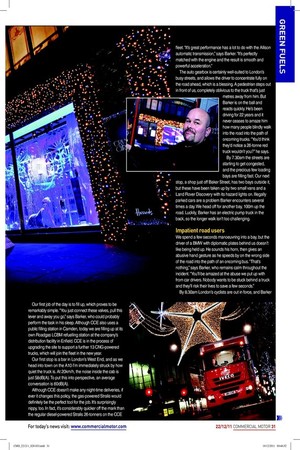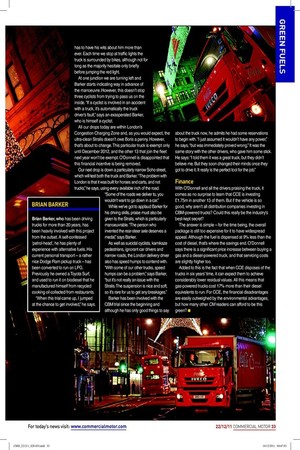CM spent a morning delivering Coca-Cola to establishments in the
Page 22

Page 24

Page 25

Page 27

If you've noticed an error in this article please click here to report it so we can fix it.
capital’s congested, pedestrianand cyclist-filled streets. How would the CBM-powered Stralis perform?
Words: Will Shiers / Images: Nigel Spreabury
It’s stupid o’clock in the morning at Coca-Cola Enterprises’ (CCE) Enfield, Middlesex, depot, and I’m desperate for a caffeine hit. I’ve been up since 4am and, unlike driver Brian Barker, I’m not used to early starts. I could really do with a Coke, but unfortunately the 20,000 bottles and cans in the back are all accounted for. We’re about to deliver them to 20 bars, shops, pubs and hotels across central London to help satisfy the capital’s insatiable thirst.
Our transport for the day is an Iveco Stralis Active Day 26-tonner, but it's no ordinary 26-tonner. Unlike the other 50 Ivecos on CCE’s 250-strong fleet, this one is running on CNG – compressed biomethane (CBM) to be exact. It’s the first CBM-powered CV to be operated anywhere in the world by CCE, and the first such Stralis to be delivered in the UK.
Slashing its carbon footprint
The truck is part of CCE’s commitment to slash its carbon footprint and has been on trial since May 2010. Darren O’Donnell, fleet logistics manager at CCE, explains that transporting goods accounts for 11% of CCE’s carbon footprint. He says the company is working hard to reduce this with innovative processes, one of which is investing in alternative fuels.
“Our main reason for selecting CBM is that it has the lowest carbon intensity of all commercially available alternative fuels, allowing us to benefit from the best possible wheel-to-wheel saving,” he says. “The gas used to make the CBM comes from a landfill site in Surrey, which means it is not depleting fossil resources. This effectively allows us to power the Stralis using the latent energy recovered from rubbish thrown away by society.” Our first job of the day is to fill up, which proves to be remarkably simple. “You just connect these valves, pull this lever and away you go,” says Barker, who could probably perform the task in his sleep. Although CCE also uses a public filling station in Camden, today we are filling up at its own Roadgas LCBM refuelling station at the company’s distribution facility in Enfield. CCE is in the process of upgrading the site to support a further 13 CNG-powered trucks, which will join the fleet in the new year.
Our first stop is a bar in London’s West End, and as we head into town on the A10 I’m immediately struck by how quiet the truck is. At 20km/h, the noise inside the cab is just 58dB(A). To put this into perspective, an average conversation is 60dB(A).
Although CCE doesn’t make any night-time deliveries, if ever it changes this policy, the gas-powered Stralis would definitely be the perfect tool for the job. It’s surprisingly nippy, too. In fact, it’s considerably quicker off the mark than the regular diesel-powered Stralis 26-tonners on the CCE fleet. “It’s great performance has a lot to do with the Allison automatic transmission,” says Barker. “It’s perfectly matched with the engine and the result is smooth and powerful acceleration.” The auto gearbox is certainly well-suited to London’s busy streets, and allows the driver to concentrate fully on the road ahead, which is a blessing. A pedestrian steps out in front of us, completely oblivious to the truck that’s just metres away from him. But Barker is on the ball and reacts quickly. He’s been driving for 22 years and it never ceases to amaze him how many people blindly walk into the road into the path of oncoming trucks. “You’d think they’d notice a 26-tonne red truck wouldn’t you?” he says.
By 7.30am the streets are starting to get congested, and the precious few loading bays are filling fast. Our next stop, a shop just off Baker Street, has two bays outside it, but these have been taken up by two small vans and a Land Rover Discovery with its hazard lights on. Illegally parked cars are a problem Barker encounters several times a day. We head off for another bay, 100m up the road. Luckily, Barker has an electric pump truck in the back, so the longer walk isn’t too challenging.
Impatient road users
We spend a few seconds manoeuvring into a bay, but the driver of a BMW with diplomatic plates behind us doesn’t like being held up. He sounds his horn, then gives an abusive hand gesture as he speeds by on the wrong side of the road into the path of an oncoming bus. “That’s nothing,” says Barker, who remains calm throughout the incident. “You’ll be amazed at the abuse we put up with from car drivers. Nobody wants to be stuck behind a truck and they’ll risk their lives to save a few seconds.” By 8.30am London’s cyclists are out in force, and Barker has to have his wits about him more than ever. Each time we stop at traffic lights the truck is surrounded by bikes, although not for long as the majority hesitate only briefly before jumping the red light.
At one junction we are turning left and Barker starts indicating way in advance of the manoeuvre. However, this doesn’t stop three cyclists from trying to pass us on the inside. “If a cyclist is involved in an accident with a truck, it’s automatically the truck driver’s fault,” says an exasperated Barker, who is himself a cyclist.
All our drops today are within London’s Congestion Charging Zone and, as you would expect, the ultra-clean Stralis doesn’t owe Boris a penny. However, that’s about to change. This particular truck is exempt only until December 2012, and the other 13 that join the fleet next year won’t be exempt. O’Donnell is disappointed that this financial incentive is being removed.
Our next drop is down a particularly narrow Soho street, which will test both the truck and Barker. “The problem with London is that it was built for horses and carts, and not trucks,” he says, using every available inch of the road.
“Some of the roads we deliver to, you wouldn’t want to go down in a car.” While we’ve got to applaud Barker for his driving skills, praise must also be given to the Stralis, which is particularly manoeuvrable. “The person who invented the rear-steer axle deserves a medal,” says Barker.
As well as suicidal cyclists, kamikaze pedestrians, ignorant car drivers and narrow roads, the London delivery driver also has speed humps to contend with. “With some of our other trucks, speed humps can be a problem,” says Barker, “but it’s not really an issue with the Stralis. The suspension is nice and soft, so it’s rare for us to get any breakages.” Barker has been involved with the CBM trial since the beginning and although he has only good things to say about the truck now, he admits he had some reservations to begin with. “I just assumed it wouldn’t have any power,” he says, “but was immediately proved wrong.” It was the same story with the other drivers, who gave him some stick. He says: “I told them it was a great truck, but they didn’t believe me. But they soon changed their minds once they got to drive it. It really is the perfect tool for the job.”
Finance
With O’Donnell and all the drivers praising the truck, it comes as no surprise to learn that CCE is investing £1.75m in another 13 of them. But if the vehicle is so good, why aren’t all distribution companies investing in CBM-powered trucks? Could this really be the industry's best-kept secret?
The answer is simple – for the time being, the overall package is still too expensive for it to have widespread appeal. Although the fuel is dispensed at 90/6 less than the cost of diesel, that’s where the savings end. O’Donnell says there is a significant price increase between buying a gas and a diesel-powered truck, and that servicing costs are slightly higher too.
Added to this is the fact that when CCE disposes of the trucks in six years’ time, it can expect them to achieve considerably lower residual values. All this means that gas-powered trucks cost 170/6 more than their diesel equivalents to run. For CCE, the financial disadvantages are easily outweighed by the environmental advantages, but how many other CM readers can afford to be this green? ■













































